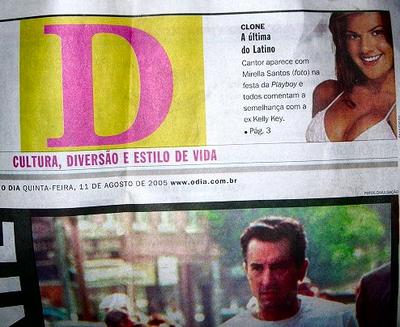Further Rio musings
 I've wanted to add a new blog entry for the past several days, but alas, time wouldn't allow this. There is precious little to spare of that most precious of commodities. There is so little of it, that I wish I had access to a magical device that would allow me to be two places at once, as Hermione Granger enjoyed in one or other of the Harry Potter novels. The best I can do here is to read a book while I am also traveling by bus or taxi or plane from one part of the city (or the world) to another. In this way, I've just finished an immensely enjoyable book, Boris Akunin's Murder on the Leviathan (the second Erast Fandorin novel to be translated into English; the third, The Turkish Gambit, should be waiting for me when I arrive home at the end of the month, thanks to internet shopping). But I am already going off on tangents, and I haven't even begun this new post, for which I've received entreaties, from far corners of the world. As I seem to work best improvising around photos--and perhaps these will keep me out of trouble, as well--I'd like to pick up where I left off, at Cinelândia in downtown Rio de Janeiro. Standing proudly there, cast in bronze, is the late 19th century Brazilian composer of Italian opera, Carlos Gomes (1836-1896).
I've wanted to add a new blog entry for the past several days, but alas, time wouldn't allow this. There is precious little to spare of that most precious of commodities. There is so little of it, that I wish I had access to a magical device that would allow me to be two places at once, as Hermione Granger enjoyed in one or other of the Harry Potter novels. The best I can do here is to read a book while I am also traveling by bus or taxi or plane from one part of the city (or the world) to another. In this way, I've just finished an immensely enjoyable book, Boris Akunin's Murder on the Leviathan (the second Erast Fandorin novel to be translated into English; the third, The Turkish Gambit, should be waiting for me when I arrive home at the end of the month, thanks to internet shopping). But I am already going off on tangents, and I haven't even begun this new post, for which I've received entreaties, from far corners of the world. As I seem to work best improvising around photos--and perhaps these will keep me out of trouble, as well--I'd like to pick up where I left off, at Cinelândia in downtown Rio de Janeiro. Standing proudly there, cast in bronze, is the late 19th century Brazilian composer of Italian opera, Carlos Gomes (1836-1896).  His opera Il Guarany, based on a novel by José de Alencar, was premiered to acclaim at La Scala in 1870. Gomes's statue faces the grand Theatro Municipal (I spell it with the "h" that would have been used at the time it was completed in 19o8). This, along with the Teatro Colon in Buenos Aires (for example) is among the great monuments reflecting the dramatic urban development and modernization in late 19th and early 20th century Latin America. To the right, you can see a detail from this massive structure. On the upper left, we see a hommage to the genre of "Comedy" (as part of the repertory of classical theatre), and to the right, near the bottom of the photo, we can see inscribed the names of two great musical dramatists--"R. Wagner" and, of course, "C. Gomes."
His opera Il Guarany, based on a novel by José de Alencar, was premiered to acclaim at La Scala in 1870. Gomes's statue faces the grand Theatro Municipal (I spell it with the "h" that would have been used at the time it was completed in 19o8). This, along with the Teatro Colon in Buenos Aires (for example) is among the great monuments reflecting the dramatic urban development and modernization in late 19th and early 20th century Latin America. To the right, you can see a detail from this massive structure. On the upper left, we see a hommage to the genre of "Comedy" (as part of the repertory of classical theatre), and to the right, near the bottom of the photo, we can see inscribed the names of two great musical dramatists--"R. Wagner" and, of course, "C. Gomes."Though I am not here in Rio on a particularly professional mission, my sense of ethnomusicological curiosity never wanes, and one way that I like to satisfy this is by looking for musical references in various publications. I try to keep track of what is on display in the music sections of bookstores, and follow as much as possible the musical reportings in the daily newspapers and weekly or monthly magazines. For a relatively poor country with a famously low ratio of readers, it has always surprised me how vibrant the magazine offerings are at Rio's newsstands.
 There seems to be a large number of glossy, attractive, and highly literate magazine offerings in the area of culture, music, news, history, politics, literature and lifestyle. One of these is Bravo, a monthly culture magazine that last year put out a set of CD-ROMs containing all of its back issues (it was founded sometime in the 1990s, I believe; see http://www.bravoonline.com.br/). The cover for August 2005, which you can see here on the right, shows Brazilian director Walter Salles (Central do Brasil) with American actress Jennifer Connelly, with the cover-story headline, "Hollywood está a mais perto?" ("Is Hollywood getting closer?"). Indeed, the film world does appear to getting smaller; as if in call-and-response with this article, the New York Times very recently (August 9th) had a feature about Brazilian director Fernando Meirelles (Cidade de Deus), who was selected by "Hollywood" producers to direct Ralph Fiennes in the forthcoming The Constant Gardener, set in Kenya and based on the John Le Carré novel. But more directly to music...when one opens to the index, we can see the musical topics for this issue:
There seems to be a large number of glossy, attractive, and highly literate magazine offerings in the area of culture, music, news, history, politics, literature and lifestyle. One of these is Bravo, a monthly culture magazine that last year put out a set of CD-ROMs containing all of its back issues (it was founded sometime in the 1990s, I believe; see http://www.bravoonline.com.br/). The cover for August 2005, which you can see here on the right, shows Brazilian director Walter Salles (Central do Brasil) with American actress Jennifer Connelly, with the cover-story headline, "Hollywood está a mais perto?" ("Is Hollywood getting closer?"). Indeed, the film world does appear to getting smaller; as if in call-and-response with this article, the New York Times very recently (August 9th) had a feature about Brazilian director Fernando Meirelles (Cidade de Deus), who was selected by "Hollywood" producers to direct Ralph Fiennes in the forthcoming The Constant Gardener, set in Kenya and based on the John Le Carré novel. But more directly to music...when one opens to the index, we can see the musical topics for this issue:
These are admittedly hard to read from the photo. But the first article, on page 70, is about the growth of audiences for symphonic music in Brazil (Carlos Gomes is certainly smiling); the second article, on page 80, is about "the victory of rock"--another issue, I think, that might upset MV-Brasil (see my prior post, "Visit to Centro"). The third entry is a review of a CD entitled Dreaming Wide Awake, by Lizz Wright...from her website, I learned that she is a North American singer in whose style reverberates "jazz, gospel, rhythm-and-blues and the singer-songwriter tradition" (http://www.lizzwright.net/).  This issue of Bravo does approximate aspects of the musical interests of Brazil's "elite" communities. Would I the time--perhaps for a future book--I would go into these kinds of analyses further. But just for the sake of brevity, and humor, we can compare Bravo's offerings with those of the Thursday issue of O Dia ("The Day"), a daily newspaper with a populist reputation. The lead musical story of the "D" section ("Culture, Diversions, and Lifestyle") section of O Dia, is about the new girlfriend of a popular singer called "Latino," and her resemblance to another Brazilian pop singer named Kelly Key. They are both louras (blonds) and both have other attractions that help sell popular newspapers and magazines. And yes, that is Robert de Niro, too, on the front page of Section D. Nowadays, and in fact for a long time, Hollywood está pertíssimo. That's all for today! I will continue to respond to requests, as best I can...
This issue of Bravo does approximate aspects of the musical interests of Brazil's "elite" communities. Would I the time--perhaps for a future book--I would go into these kinds of analyses further. But just for the sake of brevity, and humor, we can compare Bravo's offerings with those of the Thursday issue of O Dia ("The Day"), a daily newspaper with a populist reputation. The lead musical story of the "D" section ("Culture, Diversions, and Lifestyle") section of O Dia, is about the new girlfriend of a popular singer called "Latino," and her resemblance to another Brazilian pop singer named Kelly Key. They are both louras (blonds) and both have other attractions that help sell popular newspapers and magazines. And yes, that is Robert de Niro, too, on the front page of Section D. Nowadays, and in fact for a long time, Hollywood está pertíssimo. That's all for today! I will continue to respond to requests, as best I can...

1 Comments:
I managed to see a good bit of that Il Guarany, with Placido Domingo in Washington a few years (or more) ago. Lovely, exotic sets is all I can remember, and the person I was with needed to beat an early exit, so I missed the back end.
It seems to me that the mass communications/media in Brazil are probably owned by the same corporate crowd as anywhere else that has some coin to spend. They are busy pushing the corporate product.
Post a Comment
<< Home